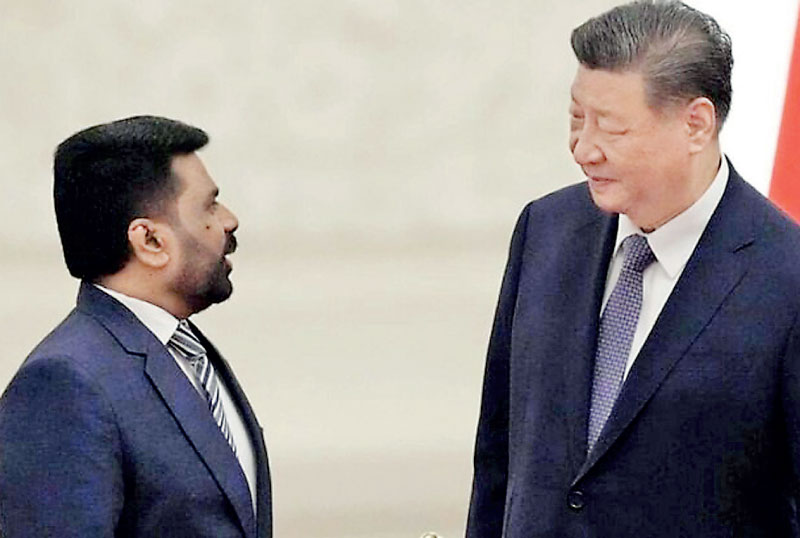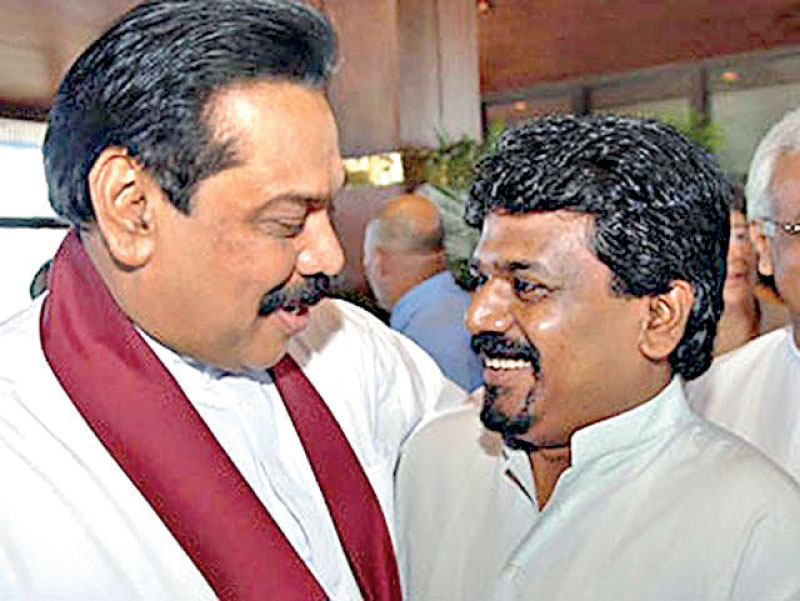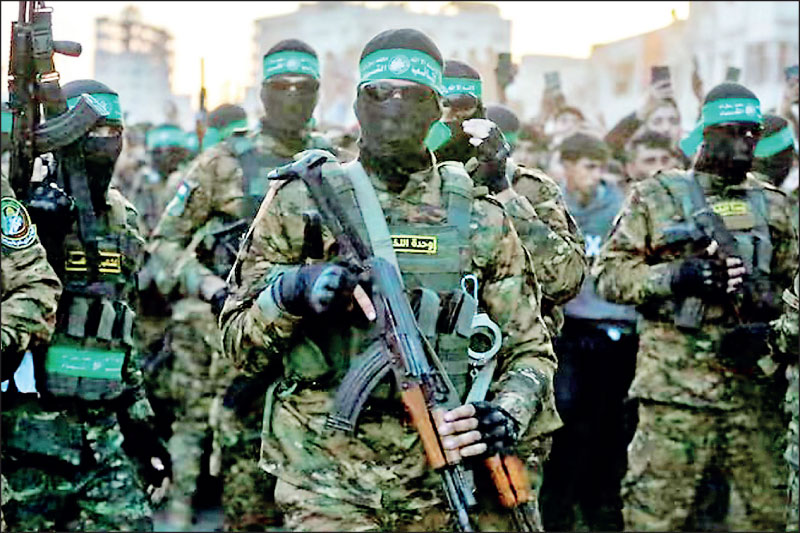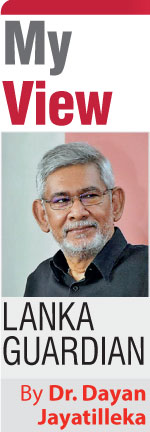Tuesday Apr 22, 2025
Tuesday Apr 22, 2025
Thursday, 23 January 2025 03:31 - - {{hitsCtrl.values.hits}}

Trinco tank farm and oil refinery too

Oil refinery in Hambantota

Potential evictor with potentially evicted

Hamas resistance fighters at Gaza hostage handover
‘…Sri Lanka is discussing building an oil refinery in India which can make use of a joint venture tank farm nearby, President Anura Kumara Dissanayake has said. “We suggested to India that we build a joint venture oil refinery,” he told a public meeting in Katukurunda, Sunday. “Discussions are under way. We have to refine oil use the tanks and become a nation that export fuel to the world. We can make it a good hub…”’
(https://economynext.com/sri-lanka-discussing-oil-refinery-in-trinco-with-india-president-200288/)
 President Dissanayake sat across the table from President Xi, looked him in the eye, and in his second reference within seconds (he’d got it right in his first) called the People’s Republic of China (PRC), the ‘Republic of China’ (“Cheena Samoohaanduwa”), scoring a first by any visiting head of state including Richard Nixon.
President Dissanayake sat across the table from President Xi, looked him in the eye, and in his second reference within seconds (he’d got it right in his first) called the People’s Republic of China (PRC), the ‘Republic of China’ (“Cheena Samoohaanduwa”), scoring a first by any visiting head of state including Richard Nixon.
If economics was the only dimension of national existence and if China and Sri Lanka were the only countries on the planet, President Anura Kumara Dissanayake’s first state visit to China would be a resounding, unqualified success. He met a wide spectrum of Chinese investors, and actually signed a deal for Sri Lanka’s largest ever FDI infusion: a state-of-the-art oil refinery in Hambantota, abutting the Port leased to China for 99-years by Ranil Wickremesinghe.
The Sri Lanka-PRC Joint Statement made good reading, with Sri Lanka piggy-backing on China’s main global economic initiative and China continuing to help Sri Lanka’s development with multidimensional cooperation.
However, President AKD’s China visit must be read together with his India visit and its operational aftermath. Then the big picture emerges.
Deep geo-existential threat
That picture is of a small island without any geographic space which can be affordably conceded or traded, inviting a large Indian footprint in its North-East and a large Chinese footprint in its Deep South.
AKD is conceding an Indian sphere of influence in the island’s North-East and a Chinese sphere of influence in its Deep South. This is a terrible idea for any small country. The fact that India and China are Asian competitors/rivals makes it worse. The further fact that one of them is a Great Power which is increasingly the target of the aging yet aggressive superpower, the USA, makes AKD’s formula dangerously reckless.
President Anura Dissanayake’s is a ‘dual entanglement’ or ‘double entrenchment’ (India, China) model. He doesn’t grasp the difference between engagement (good), entanglement (bad) and entrenchment (ugly). In external relations he lacks discernment, prudence, guardrails, redlines, and the ability to discriminate.
Let’s start with geostrategic or if I may coin a term, geo-existential, basics. A story that most Sri Lankan children and almost all Sinhalese children get to read or are told, is that of little prince Dutugemunu, whose mother Vihara Maha Devi came upon him asleep, curled-up (a foetal position). When she inquired why he was in so uncomfortable a sleeping position, he famously replied that he could not stretch out and sleep normally because of the enemy (‘alien Tamil’) encampment to the north of him and the Indian Ocean (‘the silent sea’) to the south of him.
The rebellious boy’s reply reveals a deep geostrategic sense and meaning. Speaking from the security of a kingdom in the Deep South (the ‘Ruhuna’) he is nonetheless insecure, hemmed in from both North and South. From the North, the threat is evident. From the South, not so. But while he is unthreatened in the South, he is nonetheless vulnerable. His stated reason is correct: the ocean; the lack of any hinterland and defence-in-depth.
Dutugemunu’s rupture with his father (hence the conferred prefix ‘Dutu’ i.e., ‘dushta’, ‘mean, badass’) and eventual push northwards can be understood as a geostrategic imperative. He cannot afford to concede the North—where the enemy entrenchment is an extension and entrenchment of the downward push from the neighbouring Behemoth, hence ‘alien/foreign Tamils’—because he has nothing to the South of him. The reunification of the island’s territory “under a single banner” is a geostrategic and existential imperative.
Mahinda Rajapaksa from the Ruhuna reunified the island’s territory as a single statal space after a Thirty Years war. The inability of Israel, a high-tech military sub-superpower, to fulfil its stated aim of eradicating Hamas in Gaza, a small flat urban area, underscores:
a) The superiority of Hamas as a fighting force even with its leaders killed, relative to the much-glorified LTTE.
b) The titanic achievement of President Mahinda Rajapaksa and the Sri Lankan armed forces with him as Commander-in-Chief.
Gracious and gallant as ever, AKD insists that MR, who turns 80 this year, promptly pays his rent or be evicted, possibly without a security contingent.
President Premadasa had already seen the back of a military contingent from the neighbouring state. After the long war had been won, no leader --including President Sirisena-- granted or acquiesced in foreign spheres of influence, even economic spheres of influence, in the North-East or South.
Until Ranil Wickremesinghe that is. Already in 2001, his first stint as elected PM, Ranil had surfaced the idea of physical and economic connectivity with South India, including Tamil Nadu. When he returned as Prime Minister 15 years later, he returned to the theme with enthusiastic reciprocity from the India’s Minister Nitin Gadkari. President Sirisena waged a rearguard action, making only the most minimal concessions even on the Trincomalee oil tank farm despite requests from Prime Minister Modi. Reappointed PM and then President in 2022, Ranil Wickremesinghe --who had no mandate to do so-- and Prime Minister Modi agreed on connectivity. The SJB’s Dr. Harsha de Silva stridently supports physical and economic integration with Tamil Nadu/South India.
On China and the Deep South, Ranil as PM in 2015-2019 swung from one extreme to the other. Having arbitrarily stopped the Port City project in Colombo and unable to pay his mounting bills, he offered China a 99-year lease and a large extent of land around the Hambantota Port which China had built at Mahinda Rajapaksa’s request. MR had kept China’s footprint in Hambantota relatively modest.
Indian preponderance over our North and East with a corridor to the North-Central Province, and a large Chinese footprint in the South, was Ranil Wickremesinghe’s plan. His old buddy Milinda Moragoda’s Pathfinder Foundation fleshed out the strategy of integrating the island on whatever terms, at whatever cost, for however long, with whichever foreign power—India, China, USA, Japan or preferably all of them.
Moragoda held that anything was better than devolution of power to the Tamils and the way to take the 13th amendment off the table was to economically cede the North and East to India. This trade-off was Moragoda’s mandate as Gotabaya’s appointee as High Commissioner to Delhi. He leveraged his close friendship with Ranil, Gotabaya and Mahinda Samarasinghe (Washington) to remotely steer Sri Lanka into a new matrix of dependent, subaltern existence.
President Anura Kumara Dissanayake, leader of the Marxist JVP and the ‘left-populist’ NPP, is implementing to the max the Ranil Wickremesinghe-Milinda Moragoda vision. Even the Chinese oil refinery in Hambantota had been negotiated by Kanchana Wijesekara under Ranil’s (unelected) Presidency.
Expand, Enmesh, Entrench
Anura obviously thinks he knows better than both Dutugemunu and Arthashasthra author Chanakya/Kautilya.
Though Anura has admirably ducked Ranil’s commitment on land connectivity which makes for contiguity, his administration is moving ahead as no previous Government has on a grid of projects in the Eastern province, with Trincomalee as the hub, which will not merely integrate the area tightly with India but will make Sri Lanka effectively energy-dependent on India. By inviting India to build an oil refinery next to the oil tank farm, the JVP-NPP leader is giving India the largest footprint in the North-East that any Lankan leader ever has.
Kautilya warned in the Arthashasthra that the main security threat to any state ineluctably came from its neighbour, however benign, precisely because as neighbour there’s always something to be contested. I would add there’s also the natural ‘pull factor’ if it is an ethnic kin-state, as is the (South) India-Sri Lanka case.
An economic-infrastructural sphere of influence run by the neighbouring ruler’s crony corporate giant, has an inevitable security dimension attached because any country protects its economic stake with military force. Wherever the Dutch and British East India companies went, their navies and armies followed.
Some previous rulers of the island thought themselves astute in trading-in the Portuguese for the Dutch and the Dutch for the British, but were reviled by the people for the colossal folly of a tradeoff “giving ginger and taking chillies”.
AKD probably thinks he’s cleverly balancing India off by giving China an enlarged foot-print in Hambantota at the other end of the small island—and vice versa. He’s not.
Giving the island’s apex to India and its bottom to China is not balancing. He’s increasing the pressure on Colombo from Delhi to hasten the implementation of the Indian projects of strategic scale and scope in the Northeast --radiating spokes with the vital Trincomalee district as hub. The proof is in the fact that shortly upon his return from China, Anura Dissanayake announced that he has requested India to build an oil refinery in Trincomalee adjacent to the oil tank farm.
SWRD Bandaranaike threw the British out of Trincomalee. Sirimavo secured Kachatheevu from India. AKD’s contribution is a spiral of escalating external entanglement and entrenchment.
The Chinese oil refinery with the facility of export will be perceived by strategic planners in Delhi and Washington as helpful for refuelling Chinese shipping including shipping with a military purpose. The entire Hambantota Port-oil refinery complex will be classified as ‘dual use’. AKD’s drive to implement the Ranil-Milinda roadmap will cause Trincomalee to be on China’s target list and Hambantota on India’s and the USA’s.
Anura had other options. He could have asked China to reduce the suffering of commuters and tiredness at the workplace thereby improving productivity, by gifting/investing in trains and railroads.
In a program that continues to this day, President Ranasinghe Premadasa received every year from China, without payment, the stock of textiles for the Free School Uniforms program for all schoolchildren. He made that request of China because he always prioritised direct benefit for and immediate upliftment of the largest possible number of citizens. Nothing he requested gave any foreign power a footprint. He had already removed one foreign boot-print from Sri Lankan soil, in the North and East.
By contrast President Dissanayake and the NPP have the island of Sri Lanka and the Sri Lankan state clamped in a vice, with India in the North-East and China in the Deep South. This will erode our territorial integrity won back by war, weakening the rule of the Sri Lankan state in those areas and therefore over the island’s natural borders.
Anura and the NPP assume their ongoing plans with India and China will bring rapid economic prosperity and guarantee their continued incumbency. If possessing oil refineries and even massive oil wells, and launching a ‘modernisation drive’ is a guarantee of social satisfaction then one of the most broad-based people’s revolutions of our time, the Iranian revolution against the Shah (1979), just couldn’t have happened. What counts is the content, the paradigm and pattern of development.
If successful state visits and interactions with foreign leaders can ensure political popularity, then Sirimavo Bandaranaike couldn’t have been swept out of office, never to return as the country’s leader, the year after the 5th Nonaligned Conference in Colombo and while NAM Chairperson.
Sri Lanka lost its sovereignty for 450 years from 1505 until 1948, with the island’s coastal periphery having the longest uninterrupted colonial rule in Asia. It was a semi-colony with a diminished kingdom until the British took the whole island by subterfuge and feudal treachery in 1815. The period 1505-1948 was one of inter-European, then inter-Western wars, and finally, world wars. This island was the target in the competition (initially for trade routes) between Great Powers to carve up/re-carve the world.
We lost our sovereignty for 450 years through foreign entanglements entered into by our rulers, which hardened into hegemonic entrenchment. Any Sri Lankan leader in the current period of global and Asian history must avoid external entanglements which can threaten our security, diminish our autonomy and make us a target for purposes of acquisition or denial to the rival, in the swirl of Great Power and Big Power competition. President Dissanayake has done just the opposite: he has got us entangled further and deeper in this dangerous rivalry, just as he has got us deeper into the debt trap.
Mao and Zhou Enlai coined the phrase ‘contention and collusion’ to describe the conduct of the two superpowers, USA and USSR. As Trump’s Inauguration speech clearly indicates, today, we are at the intersecting arcs of contradictions:
a) Between the USA and China for global economic space.
b) Between the Trump administration’s drive for global hegemony and the world’s majority.
c) Between India and China for the Asian/Indian Ocean space.
Even if India and China were to share this island rather than compete for it, our direction and destiny would be decided for us not by us. Whether India and China contend or collude over Sri Lanka while based on our soil, our island would not be fully ours.
This country is not destined to endure the yoke of external entrenchment. Any Sri Lankan leader is an elected temporary custodian who has no mandate to jeopardise this country fundamentally and historically. A minority president with 42% of the vote, AKD certainly doesn’t. The NPP’s 2/3rds parliamentary majority does not confer the same mandate as a 2/3rds majority does in a parliamentary (Westminster) system.
Comprador-in-Chief
In China, AKD should have requested Mao’s Selected Works. He would have encountered three relevant concepts:
i) Semi-colony/semi-colonial.
ii) Comprador.
iii) United Front.
China was not a colony said Mao, it was a semi-colony, because it was not colonized by any single power. Instead, each foreign power and sometimes a consortium of foreign powers had spheres of economic influence and ownership, mainly in the coastal cities with important ports. These economic enclaves were called “concessions”. ‘Semi-colonialism’ was one of the motivating causes for the Chinese Revolution. This is very similar to the “concessions” in Sri Lanka’s North-East (Trincomalee) and South (Hambantota), which AKD is granting.
Mao denounced as the main internal enemy, the ‘comprador bourgeoisie’ as distinct from the national bourgeoisie. ‘Comprador’ means intermediaries between foreign interests and the local setting; an elite dependent on foreign interests and facilitating them at the expense of the national interests; an elite that is the agent of foreign interests. The comprador bourgeoisie was anti-national, pro-imperialist; the national bourgeoisie, patriotic and anti-imperialist. The former should be opposed, the latter coopted. Anura Dissanayake has superseded Ranil Wickremesinghe as comprador-in-chief.
For Mao the ‘United Front’ was one of the Revolution’s “Three Magic Wands”. Anura and the NPP scorned, spurned any United Front. At the Cooperative Society elections, a cross-party “united front from below” is defeating the NPP.
(The writer was Sri Lanka’s Ambassador to the UN Geneva, France & UNESCO, and the Russian Federation.)
Discover Kapruka, the leading online shopping platform in Sri Lanka, where you can conveniently send Gifts and Flowers to your loved ones for any event including Valentine ’s Day. Explore a wide range of popular Shopping Categories on Kapruka, including Toys, Groceries, Electronics, Birthday Cakes, Fruits, Chocolates, Flower Bouquets, Clothing, Watches, Lingerie, Gift Sets and Jewellery. Also if you’re interested in selling with Kapruka, Partner Central by Kapruka is the best solution to start with. Moreover, through Kapruka Global Shop, you can also enjoy the convenience of purchasing products from renowned platforms like Amazon and eBay and have them delivered to Sri Lanka.
Discover Kapruka, the leading online shopping platform in Sri Lanka, where you can conveniently send Gifts and Flowers to your loved ones for any event including Valentine ’s Day. Explore a wide range of popular Shopping Categories on Kapruka, including Toys, Groceries, Electronics, Birthday Cakes, Fruits, Chocolates, Flower Bouquets, Clothing, Watches, Lingerie, Gift Sets and Jewellery. Also if you’re interested in selling with Kapruka, Partner Central by Kapruka is the best solution to start with. Moreover, through Kapruka Global Shop, you can also enjoy the convenience of purchasing products from renowned platforms like Amazon and eBay and have them delivered to Sri Lanka.